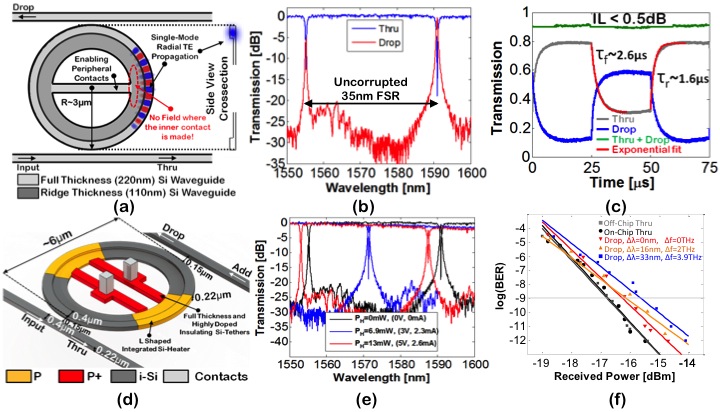L-shaped Resonant Microring Filter with Integrated Thermal Tuner
- Category: Nanotechnology, Optics & Photonics
- Tags: erman timurdogan, michael watts
Silicon photonics enables wavelength-division multiplexed (WDM) networks to be efficiently and cost effectively implemented on chip with potential for multi-terabit/s communication links. Microring-based filters perform the multiplexing and demultiplexing operations and require tight alignment between the laser line and filter resonances, which drift by process/wafer variations and dynamic temperature fluctuations. Therefore, high-speed thermo-optic control of microring filters is necessary in silicon photonic communication links. The challenge is in implementing such control efficiently. Without using complex undercut etch processes, the most efficient thermo-optic tunable filters to date have been demonstrated with a 4.4 µW/GHz tuning efficiency, 1-µs thermal time constant, and a free spectral range (FSR) of 5.6 THz[1]. For a WDM link with ± 200C variation due to processor activity, thermal tuning will consume ~1.8 mW ((M. R. Watts , W. A. Zortman , D. C. Trotter , G. N. Nielson , D. L. Luck and R. W. Yong “Adiabatic resonant microrings (ARMs) with directly integrated thermal microphotonics”, in Proc. Conf. Lasers Electro-Opt., pp.1 -2 2009.)) power as opposed to an integrated microdisk modulator with a 3-fJ/bit performance and a power consumption of 30 µW at a data rate of 10 Gb/s[2]. Therefore, it is essential to introduce new resonators. Additionally, high-speed thermal tuning can enable reconfigurable networks as well as track the dynamic processor activity. However, the buried oxide thickness around the microring filter favors either thermal tuning efficiency or speed.
In this paper[3], we introduce a new class of filters, L-shaped resonant microrings (LRM) (Figure 1), which allow for both hard outer walls and single mode propagation (Figure 1a-b) while enabling interior electrical contacts without inducing radiation or scattering. Thus, LRM filters (Figure 1d) can directly integrate a heater within the resonator, minimize the thermal capacitance, and maintain a compact size and an uncorrupted FSR (Figure 1b). Here, we demonstrate a 6-um diameter LRM filter (Figure 1d) with high efficiency (3.3 µW/GHz), high-speed (1.6 µs) thermal tuning (Figure 1c,e) and record low through-to-drop power penalty (<1.1 dB) (Figure 1f) over the 4 THz FSR (Figure 1b).

Figure 1: a) Finite difference time domain (FDTD) simulation of an LRM resonator. b) Measured spectrum of the fabricated LRM filter, showing uncorrupted 4-THz FSR on through and drop ports. c) Temporal response of the thru and drop ports of the LRM filter, excited by 20kHz 0.15V square-wave drive, fit to a 2.6-µs exponential decay and a 1.6-µs rise thermal time constant (shown in red), the insertion loss (IL) of the LRM filter is
- M. R. Watts , W. A. Zortman , D. C. Trotter , G. N. Nielson , D. L. Luck and R. W. Yong “Adiabatic resonant microrings (ARMs) with directly integrated thermal microphotonics”, in Proc. Conf. Lasers Electro-Opt., pp.1 -2 2009. [↩]
- M. R. Watts, W. A. Zortman, D. C. Trotter, R. W. Young, and A. L. Lentine, “Vertical junction silicon microdisk modulators and switches,” Opt. Exp., vol. 19, no. 22, pp. 21989–22003 2011. [↩]
- E. Timurdogan, E. S. Hosseini, G. Leake, D. D. Coolbaugh, and M. R. Watts, “L-Shaped Resonant Microring (LRM) Filter with Integrated Thermal Tuner,” in Proc. Conf. Lasers Electro-Opt., paper CTh4F.2 2013. [↩]